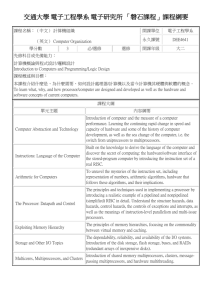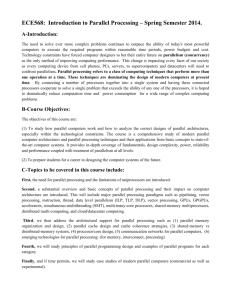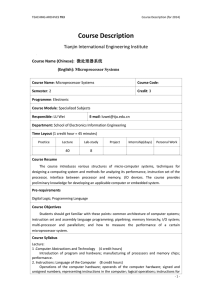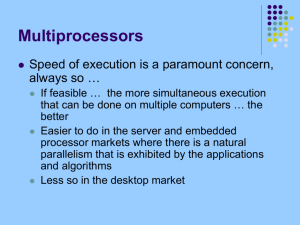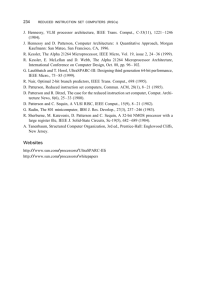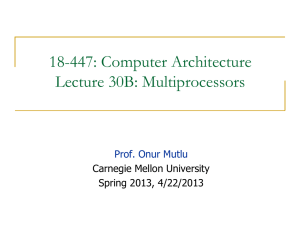Lecture8
advertisement
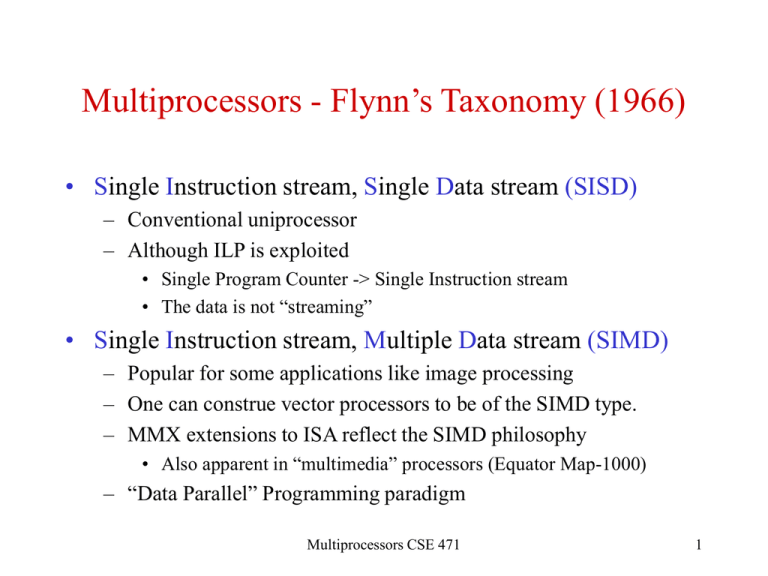
Multiprocessors - Flynn’s Taxonomy (1966) • Single Instruction stream, Single Data stream (SISD) – Conventional uniprocessor – Although ILP is exploited • Single Program Counter -> Single Instruction stream • The data is not “streaming” • Single Instruction stream, Multiple Data stream (SIMD) – Popular for some applications like image processing – One can construe vector processors to be of the SIMD type. – MMX extensions to ISA reflect the SIMD philosophy • Also apparent in “multimedia” processors (Equator Map-1000) – “Data Parallel” Programming paradigm Multiprocessors CSE 471 1 Flynn’s Taxonomy (c’ed) • Multiple Instruction stream, Single Data stream (MISD) – Until recently no processor that really fits this category – “Streaming” processors; each processor executes a kernel on a stream of data – Maybe VLIW? • Multiple Instruction stream, Multiple Data stream (MIMD) – The most general – Covers: • Shared-memory multiprocessors • Message passing multicomputers (including networks of workstations cooperating on the same problem; grid computing) Multiprocessors CSE 471 2 Shared-memory Multiprocessors • Shared-Memory = Single shared-address space (extension of uniprocessor; communication via Load/Store) • Uniform Memory Access: UMA – With a shared-bus, it’s the basis for SMP’s (Symmetric MultiProcessing) – Cache coherence enforced by “snoopy” protocols – Number of processors limited by • Electrical constraints on the load of the bus • Contention for the bus – Form the basis for clusters (but in clusters access to memory of other clusters is not UMA) Multiprocessors CSE 471 3 SMP (Symmetric MultiProcessors aka Multis) Single shared-bus Systems Proc. Caches Shared-bus I/O adapter Interleaved Memory Multiprocessors CSE 471 4 Shared-memory Multiprocessors (c’ed) • Non-uniform memory access: NUMA – – – – NUMA-CC: cache coherent (directory-based protocols or SCI) NUMA without cache coherence (enforced by software) COMA: Cache Memory Only Architecture Clusters • Distributed Shared Memory: DSM – Most often network of workstations. – The shared address space is the “virtual address space” – O.S. enforces coherence on a page per page basis Multiprocessors CSE 471 5 UMA – Dance-Hall Architectures & NUMA • Replace the bus by an interconnection network – Cross-bar – Mesh – Perfect shuffle and variants • Better to improve locality with NUMA, Each processing element (PE) consists of: – Processor – Cache hierarchy – Memory for local data (private) and shared data • Cache coherence via directory schemes Multiprocessors CSE 471 6 UMA - Dance-Hall Schematic Processors … Caches Interconnect … Main memory modules Multiprocessors CSE 471 7 NUMA Processors … caches Local memories Interconnect … Multiprocessors CSE 471 8 Shared-bus • Number of devices is limited (length, electrical constraints) • The longer the bus, the alrger number of devices but also becomes slower because – Length – Contention • Ultra simplified analysis for contention: – Q = Processor time between L2 misses; T = bus transaction time – Then for 1 process P= bus utilization for 1 processor = T/(T+Q) – For n processors sharing the bus, probability that the bus is busy B(n) = 1 – (1-P)n Multiprocessors CSE 471 9 Cross-bars and Direct Interconnection Networks • Maximum concurrency between n processors and m banks of memory (or cache) • Complexity grows as O(n2) • Logically a set of n multiplexers • But also need of queuing for contending requests • Small cross-bars building blocks for direct interconnection networks – Each node is at the same distance of every other node Multiprocessors CSE 471 10 An O(nlogn) network: Butterfly 0 To go from processor i(xyz in binary) to processor j (uvw), start at i and at each stage k follow either the high link if the kth bit of the destination address is 0 or the low link if it is 1. For example the path to go from processor 4 (100) to processor 6 (110) is marked in bold lines. 1 2 3 4 5 6 7 Multiprocessors CSE 471 11 Indirect Interconnection Networks • Nodes are at various distances of each other • Characterized by their dimension – Various routing mechanisms. For example “higher dimension first” • • • • 2D meshes and tori 3D cubes More dimensions: hypercubes Fat trees Multiprocessors CSE 471 12 Mesh Multiprocessors CSE 471 13 Message-passing Systems • Processors communicate by messages – Primitives are of the form “send”, “receive” – The user (programmer) has to insert the messages – Message passing libraries (MPI, OpenMP etc.) • Communication can be: – Synchronous: The sender must wait for an ack from the receiver (e.g, in RPC) – Asynchronous: The sender does not wait for a reply to continue Multiprocessors CSE 471 14 Shared-memory vs. Message-passing • An old debate that is not that much important any longer • Many systems are built to support a mixture of both paradigms – “send, receive” can be supported by O.S. in shared-memory systems – “load/store” in virtual address space can be used in a messagepassing system (the message passing library can use “small” messages to that effect, e.g. passing a pointer to a memory area in another computer) Multiprocessors CSE 471 15 The Pros and Cons • Shared-memory pros – Ease of programming (SPMD: Single Program Multiple Data paradigm) – Good for communication of small items – Less overhead of O.S. – Hardware-based cache coherence • Message-passing pros – Simpler hardware (more scalable) – Explicit communication (both good and bad; some programming languages have primitives for that), easier for long messages – Use of message passing libraries Multiprocessors CSE 471 16 Caveat about Parallel Processing • Multiprocessors are used to: – Speedup computations – Solve larger problems • Speedup – Time to execute on 1 processor / Time to execute on N processors • Speedup is limited by the communication/computation ratio and synchronization • Efficiency – Speedup / Number of processors Multiprocessors CSE 471 17 Amdahl’s Law for Parallel Processing • Recall Amdahl’s law – If x% of your program is sequential, speedup is bounded by 1/x • At best linear speedup (if no sequential section) • What about superlinear speedup? – Theoretically impossible – “Occurs” because adding a processor might mean adding more overall memory and caching (e.g., fewer page faults!) – Have to be careful about the x% of sequentiality. Might become lower if the data set increases. • Speedup and Efficiency should have the number of processors and the size of the input set as parameters Multiprocessors CSE 471 18 Chip MultiProcessors (CMPs) • Multiprocessors vs. multicores – Multiprocessors have private cache hierarchy (on chip) – Multicores have shared L2 (on chop) • How many processors – Typically today 2 to 4 – Tomorrow 8 to 16 – Next decade ??? • Interconnection – Today cross-bar – Tomorrow ??? • Biggest problems – Programming (parallel programming language) – Applications that require parallelism Multiprocessors CSE 471 19
